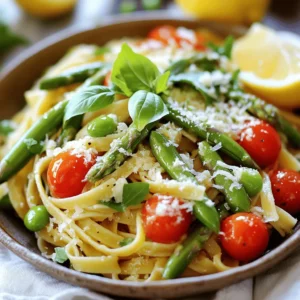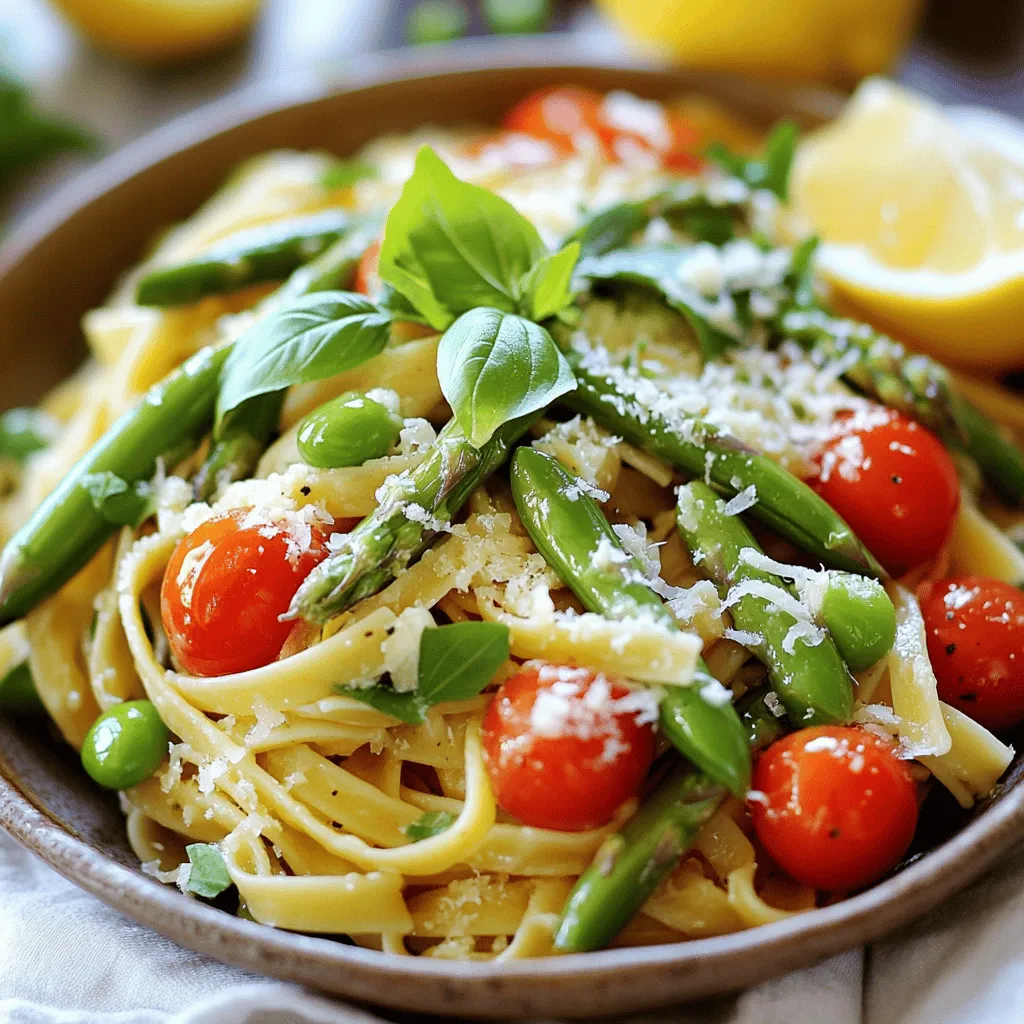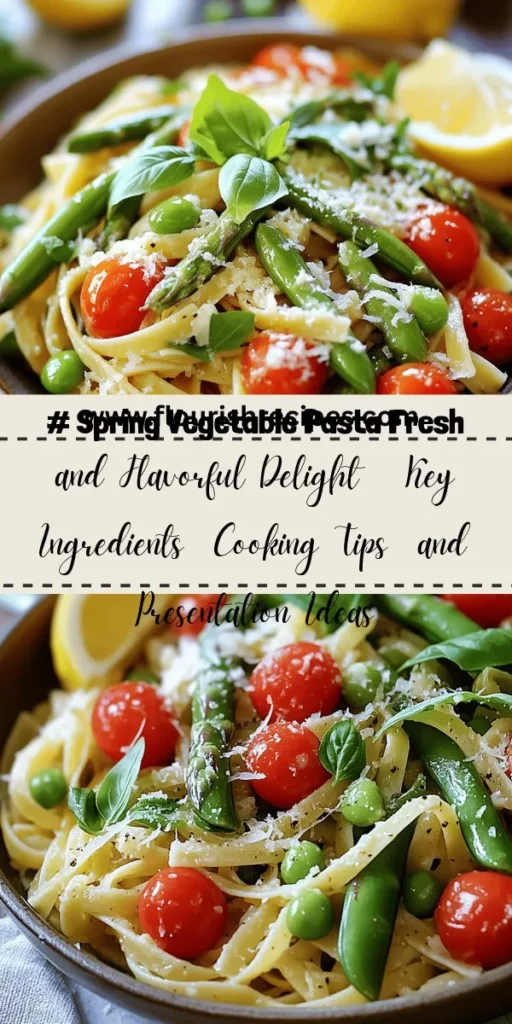Spring is the perfect time to enjoy fresh, vibrant flavors, and what better way to celebrate than with a delicious Spring Vegetable Pasta? Loaded with seasonal veggies like asparagus, zucchini, and peas, this dish is both easy and healthy. In this article, I’ll guide you through key ingredients, cooking techniques, and presentation tips to create a satisfying meal. Let’s dive into this fresh and flavorful delight!
What are the Key Ingredients for Spring Vegetable Pasta?
Spring vegetable pasta shines with fresh spring vegetables. You can use vibrant asparagus, sweet snap peas, and juicy cherry tomatoes. Each of these adds color and taste. Zucchini also works great, bringing a soft texture to the dish.
Which Fresh Spring Vegetables Can Be Used?
For this dish, I love using asparagus, snap peas, zucchini, and cherry tomatoes. Asparagus gives a nice crunch and a hint of earthiness. Snap peas add a fresh, sweet bite. Zucchini adds a lightness that pairs well with the other veggies. Cherry tomatoes burst with flavor when cooked.
How Can Seasonal Ingredients Enhance Flavor?
When you use seasonal ingredients, you get the best taste. These vegetables are at their peak in spring, so they have more flavor and nutrients. Fresh produce also means less time cooking, keeping the veggies bright and crisp. I always notice a big difference when I use fresh spring vegetables in my pasta.
What Are Ideal Pasta Choices for This Dish?
For this spring vegetable pasta, I recommend using linguine or spaghetti. Both noodles capture the sauce and veggies well. They are easy to cook and pair nicely with light dishes. Use these pasta types to keep the meal simple and delicious.
For the full recipe, follow the steps carefully. Enjoy making this fresh and flavorful dish!
How Do You Prepare and Cook Spring Vegetable Pasta?
To make spring vegetable pasta, we start with the pasta. First, boil water in a large pot. Add salt for flavor. Cook your linguine or spaghetti based on the package guide. Aim for al dente, which means firm but not hard. When done, save half a cup of water before draining the pasta. This water helps the sauce later.
Next, we sauté the fresh vegetables. Heat olive oil in a large skillet over medium heat. When it’s hot, add minced garlic. Cook it for about 30 seconds until it smells good. Then, toss in asparagus and zucchini. Sauté these for three to four minutes. Our goal is to keep them bright and slightly tender.
Now, we add the rest of the vegetables. Add snap peas and cherry tomatoes to the skillet. Stir them for another three to four minutes until the tomatoes start to soften. This step builds flavor and color in your dish.
After that, it’s time to combine everything. Add the drained pasta to the skillet. Pour in the reserved pasta water and lemon juice. Toss in chopped basil for freshness. Mix everything gently for about two minutes to warm it through.
Finally, we season it. Add salt and pepper to taste. If you like, sprinkle some grated Parmesan cheese on top. Serve the pasta in shallow bowls. Garnish with extra basil leaves and a lemon wedge for a fresh look. This dish shines with color and taste, making it a perfect spring meal. For the full recipe, check out the details above.
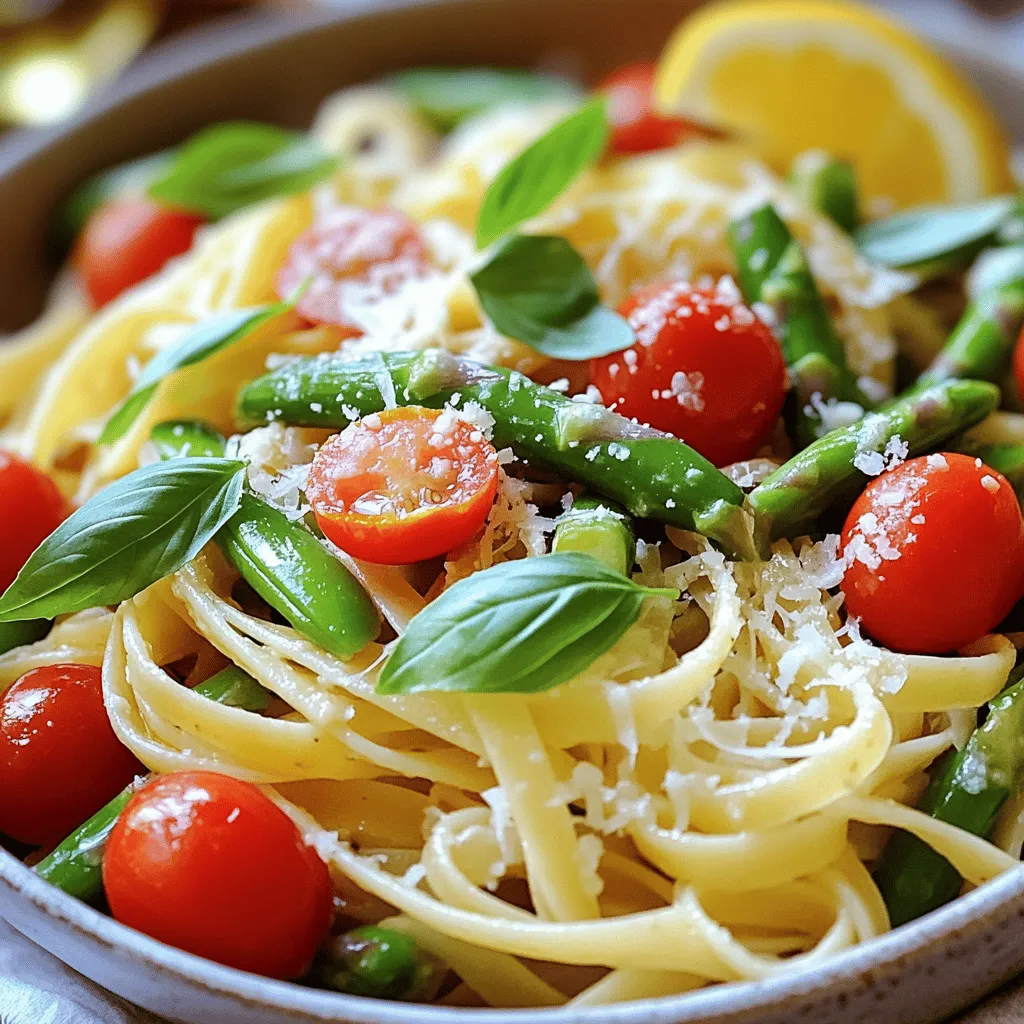
What Variation Options Exist for Spring Vegetable Pasta?
You can easily modify spring vegetable pasta to fit different tastes and diets. For vegetarian pasta recipes, swap out the Parmesan cheese for a vegan option. Nutritional yeast gives a cheesy flavor without dairy. If you’re gluten-free, use rice or chickpea pasta. These options keep the dish hearty and tasty.
For a creamy spring vegetable sauce, blend soaked cashews with garlic, lemon juice, and nutritional yeast. This creates a rich, creamy texture without heavy cream. You can also add vegetable broth for extra flavor. If you want more protein, toss in cooked lentils or chickpeas.
You can try fun sauces that pair well with spring vegetables. Pesto is one great option. You can make it with basil, spinach, or even arugula. Just blend your chosen greens with nuts and olive oil. Another option is to use a lemon-garlic olive oil drizzle. It adds brightness and enhances the fresh flavors.
When it comes to ingredient substitutions, think about what you have at home. If you lack asparagus, use broccoli or green beans. Cherry tomatoes can be replaced with diced bell peppers or sun-dried tomatoes. Always adjust the cooking time based on the vegetables you use.
For pasta with seasonal produce, think outside the box. Try adding peas, which add a sweet pop. You could also include thinly sliced radishes for a crunchy texture. Each small change can make your dish unique and exciting.
For the full recipe, you can start with the base and let your creativity shine!
How Do You Present and Garnish Your Spring Vegetable Pasta?
Garnishing your spring vegetable pasta adds a special touch. It enhances the look and taste. Start with fresh herbs. Basil and parsley work well. They add color and a fresh taste. Just sprinkle them on top before serving.
Focus on vibrant plate presentations. Use shallow bowls for serving. This allows the colors to shine. Place the pasta in the center. Arrange the veggies around it. This makes the dish inviting.
Consider food photography for pasta. Natural light brings out the colors. Take your photos from above. This angle shows all the details. A little lemon wedge can add a pop of color. It also hints at the fresh flavor inside.
Serving styles matter too. You can offer the pasta family-style. Place the whole dish on the table. This invites everyone to serve themselves. It adds a warm, cozy feel. Alternatively, serve individual portions. This offers a more formal vibe.
For the final touch, add a sprinkle of grated Parmesan cheese. It melts slightly and adds richness. You can also drizzle a bit of olive oil for shine. It looks appealing and tastes great.
Follow these tips, and your spring vegetable pasta will shine. It will be a delight for the eyes and the taste buds. For a complete guide on making this dish, check the Full Recipe.
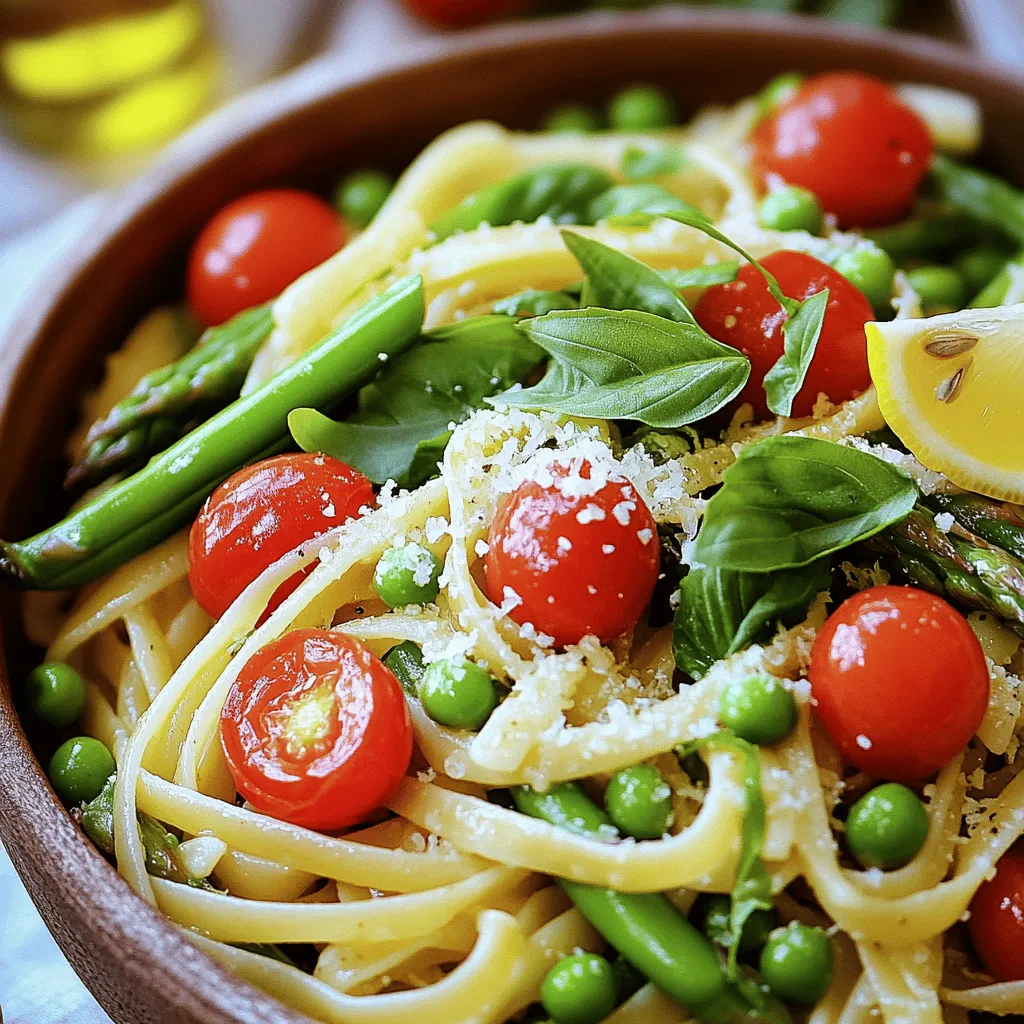
What Nutritional Benefits Do Spring Vegetables Offer in Pasta Dishes?
Spring vegetables are a delight to eat. They bring fresh flavors and many health benefits. Each vegetable offers unique nutrients that boost your health.
What Nutritional Value Do Each of the Vegetables Provide?
Asparagus is rich in vitamins A, C, and K. It helps with eye health and boosts your immune system. Snap peas are low in calories but high in fiber. They keep your digestive system healthy. Cherry tomatoes are packed with lycopene, which is good for heart health. Zucchini is low in carbs and high in water, making it great for hydration. Together, these veggies create a powerhouse of nutrients in your pasta.
How Does Spring Pasta Contribute to a Balanced Diet?
Spring pasta dishes, like Spring Vegetable Pasta, are balanced and filling. They include carbs from the pasta and nutrients from the veggies. This mix provides energy and helps you feel full. Eating a variety of vegetables supports a healthy diet. Each bite offers different vitamins and minerals that your body needs.
What Are the Benefits of Eating Seasonally?
Eating seasonally means you get the freshest flavors. Spring vegetables taste better because they are at their peak. Seasonal eating also supports local farms, which is good for the environment. Plus, seasonal foods often cost less than out-of-season ones. When you eat spring veggies, you enjoy the best of what nature has to offer! For a delicious way to use these fresh ingredients, try the Full Recipe for Spring Vegetable Pasta.
How Can You Make Spring Vegetable Pasta Part of Your Meal Prep Routine?
Meal prepping helps you enjoy quick meals all week. To start, cook a big batch of spring vegetable pasta. You can make it fresh or store it for later. This dish is light and packed with flavors. It fits well into busy schedules.
What Are Strategies for Efficient Meal Prep?
First, choose a day to cook. I like Sundays for meal prep. Cook the spring vegetable pasta and let it cool. Divide it into portions. Use clear containers to see what you have. Label each container with the date. This helps you track freshness.
How Can You Store and Reheat Spring Vegetable Pasta Effectively?
Store your pasta in the fridge for up to four days. Use an airtight container to keep it fresh. When ready to eat, reheat it in the microwave. Add a splash of water for moisture. Stir it often to heat evenly. You can also use a skillet over low heat. Add a little olive oil to bring back flavor.
What Are Ideas for Incorporating Leftovers Into Other Meals?
Leftovers can be fun! Mix spring vegetable pasta with eggs for a quick breakfast. Use it as a filling in a wrap with some greens. You can also toss it into a salad for lunch. This way, you get creative and reduce waste. Meal prepping makes dinner easy and tasty! For the full recipe, check out the Spring Vegetable Pasta section.
Spring vegetable pasta is a fresh, colorful dish full of flavor and nutrition. We explored the best spring veggies and how they enhance taste. You learned about cooking techniques that make pasta tasty and quick. We discussed flavorful variations and how to make your dish look great. Embracing seasonal ingredients not only supports health but also boosts meal prep options. Use these tips to enjoy light, healthy meals that bring joy to your table.
